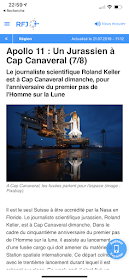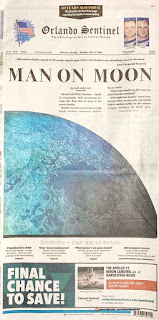 |
| Kennedy Space Center : un monde fou, fou, fou pour fêter les 50 ans d'Apollo 11 ce 21 juillet 2019. - Photo : rke |
Planté devant un très petit poste de télévision cathodique en noir-blanc, un jeune ado pas encore geek (mais presque) a les yeux rivés devant les images en direct d’Apollo 11, en provenance de la Lune. Armstrong pose son pied, puis Aldrin. Je suis subjugué, envahi par une grande admiration de ce que l’Homme est capable de réaliser. Il est 3h56 du matin en Suisse ce 21 juillet 1969, le temps est très nuageux et on ne voit pas la Lune. Mais les deux hommes, quasi fantomatiques, qui déambulent, sont bien-là. Tout comme ma grand-mère Léontine qui s’est réveillée tout exprès pour l’occasion. Elle est fan des grands événements, de somptueuses cérémonies, comme l’épopée des Kennedy ou les princesses royales. Elle est plus qu’admirative devant ces images captivantes, quasi envoûtantes. Je pense avoir un peu hérité d’elle en ce qui concerne les grands moments de l’histoire.
Le direct dure plus d’une heure et demie, le jour se lève. Le pas de géant, c’est d’avoir prouvé que l’humanité peut accomplir de grandes choses si elle le veut, même sauver la planète bleue de son agonie écologique.
 |
| À l'entrée du centre spatial, il est tombé dans le canal. Attention aux alligators. - Photo : rke |
Ces derniers jours, j’ai reçu de nombreux messages de mes lecteurs du village de Pleigne qui me suivent fidèlement.
- Tout d’abord de Pierre-André Grossenbacher, féru d’hélicoptères qui ne loupe pas une occasion de me saluer dès que j’arrive aux USA (en général, c’est le premier à m’écrire)
- Puis d’Hubert Ackermann, ancien instituteur, ancien maire (12ans), ancien rédacteur en chef de L’Écho de l’Arche (actualités des villages du Haut-Plateau delémontain), qui vient de me dire que je suis un terrestre-extra
- Enfin, le message de ma cousine Françoise Brosy qui me signale une petite anecdote : « le jour où on a marché sur la Lune, c’était le baptême de ma fille Géraldine et tous les invités étaient davantage intéressés par l’événement que par la cérémonie ». Géraldine, qui a fêté ses 50 ans le 11 juillet 2019, a quand même de la chance d’être née une année historique
.
Ci-dessous, l’article de Benjamin Fleury du Quotidien Jurassien du 20 juillet 2019, me concernant. Traduit en anglais pour mon lectorat américain
Dans le Jura, des étoiles plein les yeux
- L’exploit du 21 juillet 1969 a marqué toute une génération. Les Jurassiens Roland J. Keller et Eric Ankii ont été captifs tout particulièrement par la première conquête lunaire
- Le premier est actuellement à Cap Canaveral en pèlerinage. Le second avait assisté au lancement de ta fusée sur place, ce qui fut le début d'une aventure folle de 800 000 km
 |
| Le Quotidien Jurassien du 20 juillet 2019 - www.lqj.ch |
Les premiers pas de |’Homme sur la Lune, par le commandant Neil Armstrong et Buzz Aldrin, sont un souvenir qui restera marqué à jamais dans les esprits des personnes en âge de s’en rappeler. A 3h56, heure suisse, les images floues transmises par la NASA aux chaines de télévision laissaient deviner |’événement historique. L’aboutissement d’années de préparations, mais aussi de rivalité entre les deux grandes puissances de la Guerre froide: les LSA et PURSS.
Dans le Jura, à Peigne, ce fut une nuit blanche pour Roland J. Keller, alors âgé de 13 ans. «Je regardais la télévision avec ma grand-mère et cela a allumé ma passion. Ce phénomène d’être sur la Lune m’a attiré», confie le journaliste jurassien qui habite aujourd’hui Courrendlin. Cette forte attraction pour la Lune ne I’a plus quitté. Après Apollo 11, les hommes sont retournés sur le satellite de la Terre à plusieurs reprises jusqu’en 1972 grâce au programme spatial du président Kennedy. Tout au long de ces tentatives périlleuses, Roland J. Keller accumule une quantité de documents et de revues. Jusqu’à devenir un fin connaisseur de Cap Canaveral, de l’espace et des navettes voyageant entre Terre et Lune.
Il a vu les flammes de Challenger
Devenu reporter dans le domaine spatial, wu est aujourd’hui le seul Suisse a être accrédité au complexe de lancement spatial en Floride, ce qui constitue un sacré tour de force. «J’en suis fier», admet celui qui est défini dans le pays de la conquête spatiale comme «le petit Suisse qui vient voir les grandes fusées américaines». Un privilégié qui peut poser son matériel sur le pas de tir et qui est convié aux conférences de presse. À chaque fois qu’il s’y rend pour voir un lancement, l’adrénaline le prend, car ce sont souvent des mois — voire des années de travail — qui se jouent en quelques secondes. Et tout n'est pas toujours rose, comme ce fameux 28 janvier 1986 où la navette Challenger se désintégra avec sept personnes à bord, une minute après le décollage. Un instant terrible: «Il y avait beaucoup d’invités à proximité et soudain tout s’est arrêté. Plus personne ne bougeait. Sur le moment, on ne savait pas comment réagir. On a seulement fait notre travail de journaliste, à savoir récolter et envoyer les infos.» Un demi-siècle après le fameux «bond de géant pour l’humanité», une fusée partira du centre spatial demain pour ravitailler la station spatiale internationale. L’occasion pour Roland J. Keller d’assister è son 30° lancement de fusée, mais aussi, et surtout de faire un pèlerinage sur le pas de tir d’ Apollo 11, là où tout a débuté. «J’y vais, car c’est symbolique. Je veux y être», relève le journaliste, pour une fois incapable de retranscrire en mots ce qu'il ressent.
 |
| J'étais aussi en direct sur RFJ avec Jean-Michel Probst le 19 juillet 2019. - Écoutez le son : Cliquez ici |
Si certains doutent que l’homme n’ait jamais foulé la froide surface lunaire, Roland J. Keller balaye ces théories du complot d’un revers de main. «Ça aurait été plus difficile de « schinder » que d’y aller. Les chiffres sont là, la fusée a décollé.» Cela a représenté un travail de près de dix ans avec 400 OOO personnes impliquées», souligne-t-il, convaincu que l’homme a pu accomplir ce qui était fantasmé depuis des siècles.
Seize ans après Tintin, cette fois, «on a marché sur la lune».
Benjamin Fleury (Quotidien Jurassien)
.
Flash-back: from Pleigne (Switzerland) to the Moon
[Cape Canaveral, July 21, 2019, rke] – Flashback 50 years ago in a small village in Pleigne (Swiss Jura). My grandfather Arthur Brosy's farm, in the middle of the village, in the place called "La Vie de Ferrette,” a house bought and transformed by my brother Claude who now lives there with his family.
Standing in front of a very small black and white cathode television set, a young teenager who is not yet a geek (but almost) is staring at the live images of Apollo 11 from the Moon. Armstrong sets his foot down, then Aldrin. I am overwhelmed, overwhelmed by a great admiration for what Man is capable of achieving. It is 3:56 a.m. in Switzerland on July 21, 1969, the weather is very cloudy and you can't see the Moon. But the two men, almost ghostly, who are walking around. Just like my grandmother Léontine who woke up especially for the occasion. She is a fan of great events, sumptuous ceremonies, such as the Kennedy epic or royal princesses. She is more than admiring these captivating, almost bewitching images. I think I inherited a little bit from her with regard to the great moments of history.
The live broadcast lasts more than an hour and a half, the day breaks. The great step forward is to have proven that humanity can achieve great things if it wants to, even saving the blue planet from its ecological agony.
 |
| Florida Today, July 21, 1969. |
In recent days, I have received many messages from my readers in the village of Pleigne who follow me faithfully.
- First of all, Pierre-André Grossenbacher, a helicopter enthusiast who never misses an opportunity to greet me as soon as I arrive in the USA (in general, he is the first to write to me)
- Then Hubert Ackermann, former teacher, former mayor (12 years old), former editor-in-chief of L'Écho de l'Arche (news from the villages of the Haut-Plateau delémontain), who just told me that I am an earthly extra.
- Finally, the message from my cousin Françoise Brosy who tells me a little anecdote: "The day we walked on the Moon, it was the baptism of my daughter Géraldine and all the guests were more interested in the event than in the ceremony". Géraldine, who celebrated her 50th birthday on July 11, 2019, is still lucky to have been born in a historic year.
.
Article written by Benjamin Fleury in the Quotidien Jurassien dated July 20, 2019, concerning me. Translated into English for my American readership
In the Swiss Jura, stars full of eyes
- The feat of July 21, 1969, marked a whole generation. The Jurassians Roland J. Keller and Eric Ankli were particularly captive by the first lunar conquest
- The first is currently on pilgrimage to Cape Canaveral. The second one had attended the launch of your rocket on the spot, which was the beginning of a crazy 800,000 km adventure
 |
| Quotidien Jurassien. July 20, 2019. www.lqj.ch |
The first steps of Man on the Moon, by Commander Neil Armstrong and Buzz Aldrin, are a memory that will remain forever in the minds of those of us of age to remember. At 3:56 a.m. Swiss time, the fuzzy images transmitted by NASA to the television channels suggested a historical event. The result of years of preparation, but also of rivalry between the two great powers of the Cold War: the LSA and PURSS.
In the Jura, in Pleigne, it was an all-nighter for Roland J. Keller, then 13 years old. "I was watching television with my grandmother and it ignited my passion. This phenomenon of being on the Moon attracted me," says the Jura journalist who now lives in Courrendlin. This strong attraction for the Moon never left him. After Apollo 11, the men returned to the Earth's satellite several times until 1972 thanks to President Kennedy's space program. Throughout these perilous attempts, Roland J. Keller accumulated a quantity of documents and reviews. Until he became a fine connoisseur of Cape Canaveral, space and shuttles traveling between Earth and the Moon.
He Saw the Flames of Challenger
 |
| Orlando Sentinel. July 21, 1969. |
 |
| Orlando Sentinel. July 21, 2019. |
Roland J. Keller, editor-in-chief of a scientific journal for engineers, should therefore live out his "first little dream" tomorrow. Unable to go to the moon himself, does he have a second one on the blue planet? "Would like to see a rocket launch for the moon," says the man who supports President Trump on at least one point. The latter has indeed revived the idea of a lunar reconquest, several decades after NASA succeeded in its audacious bet.
While some doubt that man has never walked on the cold lunar surface, Roland J. Keller sweeps away these conspiracy theories with a flick of the wrist. "It would have been more difficult to make a fake than to go there. The numbers are there, the rocket has taken off." It represented a work of nearly ten years with 400 000 people involved," he emphasizes, convinced that man has been able to accomplish what had been fantasized for centuries.
Sixteen years after Tintin, this time "We walked on the moon.”
Benjamin Fleury


